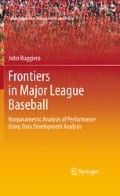Abstract
Mazur (1995) applied DEA to rank the performance of MLB players. Mazur assumed that all players had the same input level and chose three outputs: batting average, home runs, and runs batted in. These three measures comprise the “triple crown” in major league baseball. Certainly, a team would prefer players with higher values of each of these variables. However, as pointed out by Anderson and Sharpe (1997), runs batted in by a particular player largely depends on the ability of the player’s teammates to reach base prior to the at bat.
Access this chapter
Tax calculation will be finalised at checkout
Purchases are for personal use only
Notes
- 1.
Grosskopf et al. (1997) and Coelli and Perelman (1999, 2000) apply a stochastic distance function approach that does allow multiple outputs. However, this approach treats outputs asymmetrically.
- 2.
- 3.
Since DEA is sensitive to variable selection, we ran a secondary regression to test whether runs or runs batted in should be included as relevant variables. The test employed in Ruggiero (2005) was used; the results suggested that these variables should not be included. In addition, we considered an alternative model using batting average and slugging percent. The correlation between the two models was 0.71. Interestingly, when using slugging percent and batting average, the result of the test suggests that runs batted in should be included as an additional variable. For purposes of this chapter, we will use Singles Plus, Doubles, Triples, and Home Runs.
- 4.
Mauer led the American League in OPS, the sum of on-base and slugging percentages. Mauer played in 138 games and had around 100 less at bats than did Jeter or Teixeira.
- 5.
In empirical applications, expert opinion or regression analysis could be used to derive the weights.
- 6.
In the chapters evaluating Hall of Fame players and steroids, we use (5.4) to recognize the importance of the power game.
- 7.
This excludes Matt Holliday, who was traded from Oakland to St. Louis in July.
Author information
Authors and Affiliations
Corresponding author
Rights and permissions
Copyright information
© 2011 Springer Science+Business Media, LLC
About this chapter
Cite this chapter
Ruggiero, J. (2011). Evaluating Hitters. In: Frontiers in Major League Baseball. Sports Economics, Management and Policy, vol 1. Springer, New York, NY. https://doi.org/10.1007/978-1-4419-0831-5_5
Download citation
DOI: https://doi.org/10.1007/978-1-4419-0831-5_5
Published:
Publisher Name: Springer, New York, NY
Print ISBN: 978-1-4419-0830-8
Online ISBN: 978-1-4419-0831-5
eBook Packages: Business and EconomicsEconomics and Finance (R0)

